
Introduction to Prime Number in JavaScript
The prime number is a whole number greater than which can be fully divisible by two numbers including the same number itself. It’s a positive number which upon divided by the numbers less than it will not divide perfectly. Writing a program to check if a number is prime or not is a very common question asked in programming. It can be implemented on the front end by using JavaScript so that the client machine will be used for calculation. In this article, we will see how we can check if the number is Prime or not in JavaScript.
Logic
We can divide the input number by all the numbers between 1 and the numbers less than itself and check the remainder if in any of the case remainder comes as zero that means the number is fully divisible and is not prime.
Examples of Prime Number in JavaScript
Below are the examples of prime number in JavaScript:
Example #1: Using for loop
Code:
<!DOCTYPE html>
<html>
<head>
<title>
Prime Number Check in JavaScript
</title>
<style>
.results {
border : green 1px solid;
background-color : aliceblue;
text-align : left;
padding-left : 20px;
height : 150px;
width : 95%;
}
.resultText {
font-size : 20px;
font-style : normal;
color : blue;
}
</style>
</head>
<body>
<div class = "results">
<h2> Enter the Number </h2>
Number: <input type = "number" name = "number" id = "number" required>
<button type = "button" onclick = "checkForPrime()" > Submit </button>
<div class = "resultText">
<p id = "result"> </p>
</div>
</div>
</div>
<script type = "text/javascript">
function checkForPrime() {
num = document.getElementById("number").value;
if(num == '' || num < 1) {
document.getElementById("result").style.color = "red";
document.getElementById("result").innerHTML = "Please Enter a Valid Number";
return;
}
var i;
var flag = true;
if (num == 1) {
flag = false;
} else {
for(i = 2; i < num-1; i++) {
if (num % i == 0) {
flag = false;
break;
}
}
}
if(flag == true) {
document.getElementById("result").style.color = "blue";
document.getElementById("result").innerHTML = "The number: " + num + " is a Prime Number";
} else {
document.getElementById("result").style.color = "red";
document.getElementById("result").innerHTML = "The number: " + num + " is NOT a Prime Number";
}
}
</script>
</body>
</html>Here, we have called function checkForPrime() upon submitting the value. First, we have checked if the user has entered valid input. The input should not be blank or negative as prime numbers cannot be negative. Then, we have used one flag to indicate, if in the process of dividing the number by numbers from 2 to n-1 we get the remainder as zero. If we get the zero in between that means, the number is not prime and we will immediately change the status of the flag and break the loop and then declare that number as not prime. If the flag status is not changed that means, we didn’t get zero as the remainder in the process, so we will declare that number as prime.
Output:
For a valid Prime number: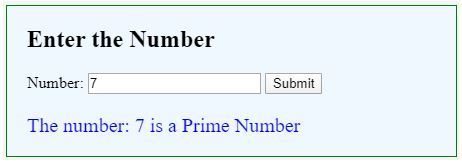
For Not Prime number:

Example #2: Using while loop
This example here is just to showcase another way of implementation in JavaScript.
Code:
<!DOCTYPE html>
<html>
<head>
<title>
Prime Number Check in JavaScript
</title>
<style>
.results {
border : green 1px solid;
background-color : aliceblue;
text-align : left;
padding-left : 20px;
height : 150px;
width : 95%;
}
.resultText {
font-size : 20px;
font-style : normal;
color : blue;
}
</style>
</head>
<body>
<div class = "results">
<h2> Enter the Number </h2>
Number: <input type = "number" name = "number" id = "number" required>
<button type = "button" onclick = "checkForPrime()" > Submit </button>
<div class = "resultText">
<p id = "result"> </p>
</div>
</div>
</div>
<script type = "text/javascript">
function checkForPrime() {
num = document.getElementById("number").value;
// valid input checking
var i;
var flag = true;
if (num == 1) {
flag = false;
} else {
i = 2;
while (i < num/2) {
if(num % i == 0) {
flag = false;
break;
}
i++;
}
}
if(flag == true) {
document.getElementById("result").style.color = "blue";
document.getElementById("result").innerHTML = "The number: " + num + " is a Prime Number";
} else {
document.getElementById("result").style.color = "red";
document.getElementById("result").innerHTML = "The number: " + num + " is NOT a Prime Number";
}
}
</script>
</body>
</html>Here, we have used a while loop for diving the number, note that we are checking divisibility up to n/2 only here. This is because of mathematical property that the number cannot be perfectly divisible by the numbers greater than half of that number. This will improve the performance as multiple divisions will be reduced here.
Output:
For a valid Prime number:
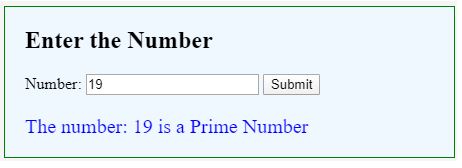
For a invalid Prime number:
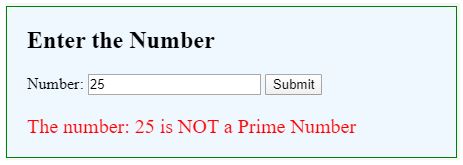
Example #3: Using Recursion
Code:
<!DOCTYPE html>
<html>
<head>
<title>
Prime Number Check in JavaScript
</title>
<style>
.results {
border : green 1px solid;
background-color : aliceblue;
text-align : left;
padding-left : 20px;
height : 150px;
width : 95%;
}
.resultText {
font-size : 20px;
font-style : normal;
color : blue;
}
</style>
</head>
<body>
<div class = "results">
<h2> Enter the Number </h2>
Number: <input type = "number" name = "number" id = "number" required>
<button type = "button" onclick = "checkForPrime()" > Submit </button>
<div class = "resultText">
<p id = "result"> </p>
</div>
</div>
</div>
<script type = "text/javascript">
function checkForPrime() {
num = document.getElementById("number").value;
if(num == '' || num < 1) {
document.getElementById("result").style.color = "red";
document.getElementById("result").innerHTML = "Please Enter a Valid Number";
return;
}
var i = 2;
var flag = isPrime(num, i);
if(flag == true) {
document.getElementById("result").style.color = "blue";
document.getElementById("result").innerHTML = "The number: " + num + " is a Prime Number";
} else {
document.getElementById("result").style.color = "red";
document.getElementById("result").innerHTML = "The number: " + num + " is NOT a Prime Number";
}
}
// new recursive function
function isPrime( num, i) {
if(num < 2) {
return false;
}
if(num == 2) {
return true;
}
if(i > num/2) {
return true;
} else {
if( num % i == 0) {
return false;
} else {
return isPrime(num , i+1);
}
}
}
</script>
</body>
</html>Output:
For a valid Prime number:
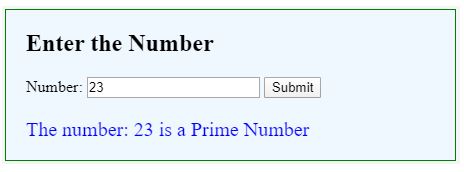
For a invalid Prime number:
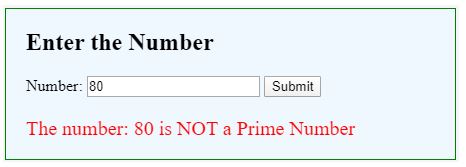
Here, we have added one new function which calls itself recursively. We have base cases as per the logic, the function will call itself until it reaches out to base cases. It will go on dividing the number by the dividing numbers i.e. 2 to n-1 and return the value based on the remainder.
Conclusion
We have seen the property number to be prime and implemented logic accordingly in the JavaScript. We can use multiple types of loops to implement the same.

